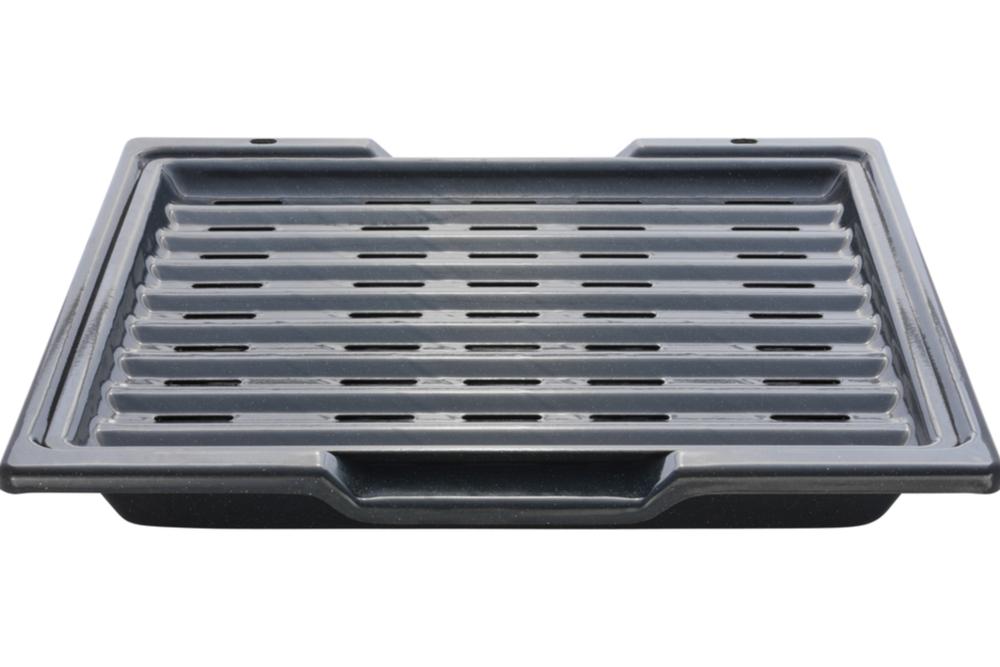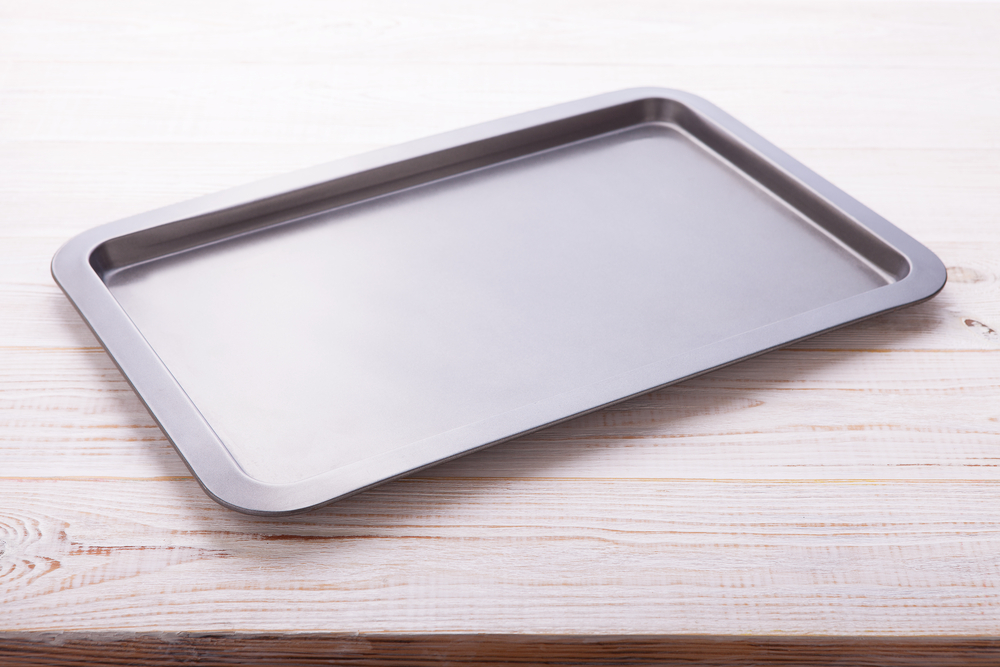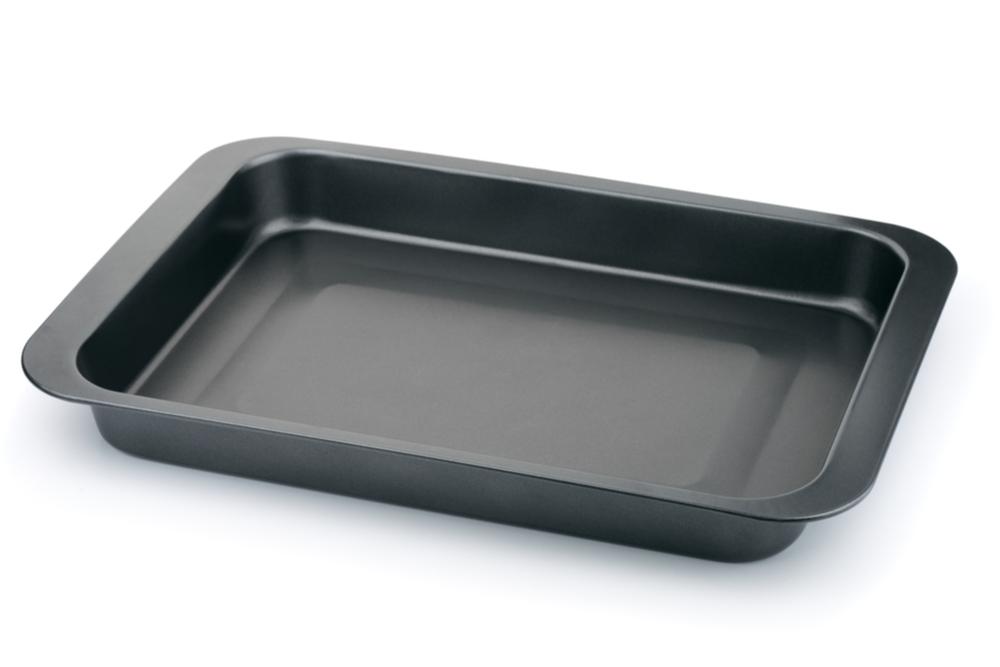Regarding cookware, it's easy to blur the lines between what tools are best for what conditions. Opting for a skillet over a saucepan in everyday cooking does little to change the outcome.
In some cases, though, specialized bakeware serves a specific purpose and adds a particular element of professionalism to even the most basic weeknight dinner. One such tool is the broiler pan, often swapped out for a baking sheet.
So, broiler pan vs. baking sheet- What's the difference? Read on the learn the answer, along with helpful tips for successfully using both.
Baking and broiling take advantage of the modern oven's ability to use the top, bottom, and back heating elements independently or in conjunction with one another.
All oven elements work together when baking foods to create an ambient internal temperature rather than applying direct heat.
Baking happens slowly at a standardized range of temperatures from 200° F to 500° F, allowing even delicate foods like custard to reach a safe internal temperature without burning the exterior
of the dish.
This cooking process is best reserved for:
Broiling, on the other hand, achieves the exact opposite. It relies on a single heating element to quickly crisp the top of a dish with targeted, exceedingly high heat, typically 500-550° F.
Many foods require both baking and broiling, such as lasagna. This Italian classic requires first baking the dish to heat the noodles and filling, followed by a few minutes of broiling to brown the cheese topping.

A Broiler Pan Has a Rack on Which The Food Rests, and a Tray Which Collects Grease and Oil
While broiling is not as common as baking in everyday cooking, it's a valuable asset for adding dimension to foods such as:
A broiler pan consists of two pieces: a high-walled tray and a perforated drip rack.
This design allows fats and oils to drip off the food you're cooking on the top rack and collect in the bottom tray.
Broiler pans are often the best choice for cooking and caramelizing veggies, thin cuts of meat, and fish, as they don't require an extended time in the oven that baking affords.
Because a broiling pan facilitates fat removal, a marinade or glaze can help your meal maintain moisture.
Unlike most oven-safe cookware, broiler pans must withstand short bursts of intense heat. That rules out non-stick coatings, silicone, and glass pans, all of which are subject to damage in those conditions.
Instead, look for bakeware that says explicitly "broiler-safe" and, if necessary, use aluminum foil to prevent sticking. Just be aware that wrapping the top rack of a broiler pan in foil negates the purpose of the perforations.
Good candidates for broiler-safe cookware include cast-iron, untreated stainless steel, and disposable aluminum pans.
When a broiler pan is unavailable, you can achieve a similar charring effect with a baking sheet or a roasting pan.
To keep the food from cooking in its own fat, place a rack at the bottom of the pan to hold the meat, veggies, or fish above the drippings.
For some applications, such as quickly toasting the top of bread or crisping pre-cooked vegetables, a baking sheet on its own serves the purpose. The broiler's high heat can cause thinner aluminum to warp, though.
Baking sheets, also known as sheet pans, provide a flat surface and low rim ideal for roasting meat and vegetables or baking certain desserts, such as cookies.
Thanks to their versatility and easy clean-up, they are ubiquitous in commercial and home kitchens.

A Baking Sheet is Shallow with Rolled Edges on Each Side
Baking sheets in the US come in a set of standard sizes, including:
Most home chefs are familiar with the eighth, quarter, and half sheet pan, with the two-thirds and full more common in commercial kitchens.
Note that while similar, a baking sheet differs slightly from a cookie sheet. A baking sheet has a raised rim with rolled edges around the outside. These rimmed baking sheets help to create a very shallow pan that is able to help prevent food from spilling over into the bottom of the oven.

A Cookie Sheet Can Be Completely Flat or have 1 or 2 Raised Edges
A cookie sheet isn't completely lined by an outside rim. A cookie sheet may be completely flat - or have one or two slightly raised edges that help you to grab on to the cookie sheet for putting the sheet into the oven.
A baking pan is similar to a baking sheet in that it is completely enclosed by an outer rim. However, baking pans are typically much deeper than a baking sheet. A baking sheet would be appropriate for cookies or biscuits - baking pans are great for loaves of bread or cakes.

A Baking Pan is Significantly Deeper Than a Baking Sheet
Because baking utilizes lower temperatures, there is a much wider variety of cookware and materials appropriate for the task.
Baking sheets are perhaps the most popular, particularly those made of aluminum, which masterfully distributes heat evenly across the surface.
Stainless steel sheet pans are heavier and more durable than aluminum but are more likely to make food stick, as they tend to have concentrated "hot spots" because they don't conduct heat as efficiently.
Other bake-safe materials include silicone (up to 428°F), glass, and ceramic.
Desserts rely on the low and slow baking process to ensure thicker foods, like batter, roasts, and casseroles, cook on the inside without burning the outside, opening the door for a large selection of oven-safe pan shapes.
Cake pans are one of the most frequently reached-for options for oven-safe cookware. They are often rectangular, round, or square, but some novel options, like heart-shaped cake pans, make specialty cakes more accessible for home bakers.
In terms of cake pan sizes, these kitchen staples boast interchangeability based on volume, giving bakers more shape options without complicated conversions.
For example, a standard 6-inch round cake pan and an 8-inch round cake pan have four cup capacities. So, a baker would simply need to determine whether they wanted larger but thinner tiers or smaller but thicker tiers rather than computing a partial recipe.
Similarly, a 9-inch round and 8x8-inch square cake pan both hold eight cups, and a 10-inch round and 9x9-inch square both have ten cup capacities.
Ideal for cheesecakes and quiches, springform cake pans have a removable bottom so that the contents don't need to be inverted.
The bottom of the pan is a thin, flat sheet that interlocks with a spring-locked ring. Once released, the outer ring unseals from the sheet and lifts away.
Muffin tins have concave cups built into the bakeware for creating individual cakes rather than a single, larger one.
Standard muffin tins have 12 cups, but mini cake pans can have up to 36.
A loaf pan, sometimes called a pound cake pan, is a necessary piece of bakeware for forming standard bread loaves. The high walls provide support while the yeast in the dough is rising.
They also provide a loaf shape to quick bread and pound cakes, despite neither relying on yeast as a leavening agent.
Bundt cake pans are heavy, non-stick bakeware with a decorative shape and a center tube, so all sides of the dessert have an evenly-baked outer crust. Standard sizing is typically 10-inches, but mini bundt cake pans offer the same unique shape for individual servings.
Despite most bundt pans featuring a non-stick coat, the complex design requires heavy greasing to avoid batter tearing away when the cake is removed.
Angel food cake pans are similar to bundt pans in that they also have a center tube but lack decorative sides. Instead, they are smooth and have a removable bottom to help the cake come out cleanly.
